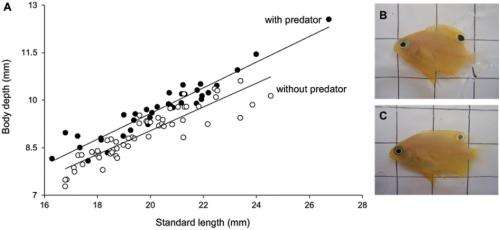July 29, 2013 report
Researchers find young angelfish grow fake eyes to ward off predators

(Phys.org) —Researchers Oona Lönnstedt and Mark McCormick of James Cook University in Australia, along with Douglas Chivers of the University of Saskatchewan, Canada, have found that young angelfish are able to grow false eyes on demand when exposed to predators. In their paper published in the journal Scientific Reports, the group describes experiments they conducted with angelfish and their predators in their lab.
Biologists have known for some time that young angelfish develop what appears to be an eye on their dorsal fin, and that their real eyes are very small in comparison. The result is a small fish that appears to be traveling in the opposite direction of its actual path—a tactic clearly meant to fool predators. What was not known, however, was that the fish are able to create the effect on-demand.
To find out what really goes on with the angelfish, the researchers collected several samples prior to their being exposed to predators and put them in several tanks in their lab. They also collected some samples of the natural predator dusky dottybacks as well as another fish called a goby that look much like dottybacks but are not meat eaters. Some of the angelfish were exposed to the predators (via plastic bag immersed in their tank or had the scent of a predator placed into their tank) on and off for six weeks, some to the goby and others to no other fish at all.
In watching how the angelfish responded in the various scenarios, the researchers found that only the specimens that were exposed to the real predators developed false eyes on their dorsal fins along with small real eyes and overall deeper bodies (another tactic that wards off attack). In studying their behavior, the researchers also noted that the angelfish that had been exposed to predators behaved more cautiously than did the other two groups. This translated to differences in the real world as well. When all of the fish were released back into the wild, those fish that had been exposed to predators had a far higher survival rate—the unexposed fish had five times the mortality rate.
More information: Predator-induced changes in the growth of eyes and false eyespots, Scientific Reports 3, Article number: 2259 doi:10.1038/srep02259
Abstract
The animal world is full of brilliant colours and striking patterns that serve to hide individuals or attract the attention of others. False eyespots are pervasive across a variety of animal taxa and are among nature's most conspicuous markings. Understanding the adaptive significance of eyespots has long fascinated evolutionary ecologists. Here we show for the first time that the size of eyespots is plastic and increases upon exposure to predators. Associated with the growth of eyespots there is a corresponding reduction in growth of eyes in juvenile Ambon damselfish, Pomacentrus amboinensis. These morphological changes likely direct attacks away from the head region. Exposure to predators also induced changes in prey behaviour and morphology. Such changes could prevent or deter attacks and increase burst speed, aiding in escape. Damselfish exposed to predators had drastically higher survival suffering only 10% mortality while controls suffered 60% mortality 72 h after release.
Journal information: Scientific Reports
© 2013 Phys.org


















